I’m so excited to finally share this!
If you’re not new here, you’re probably aware of my involvement in the Re-Love Project and what it’s all about. For those of you who don’t know, in short it’s a Feast Watson campaign in collaboration with Salvos Stores which sees seven design personalities “re-love” a neglected item of furniture with the resulting pieces being auctioned wholly for charity. Pretty cool, huh? You can read my first post about it here and learn more on the Feast Watson website here.
It’s such a wonderful campaign which I’m thrilled to be involved with.
Anyhoo, as revealed in my previous post about the project, I started with this crappy old sideboard which I picked up for just $5…
I bought this baby “site unseen” (after a friend sent me a photo) because I loved the clean mid-century lines and generous proportions.
I also really liked the fact it looked so disheveled. I know that might sound weird, however I love “sow’s ear to silk purse” makeovers, and knew I could do something completely transformative with this piece.
And how bad could it be, right?
Right?
Turns out…pretty bad.
I mean, it was clear there was a missing drawer and door (I could deal with that) though what wasn’t clear was the fact that the remaining doors and drawers were all constructed from faux wood-grain textured chipboard! And that the top and sides were nothing more than super thin faux marble laminated masonite!
Yikes!
Still, I had a vision and it was going to come to fruition!
Here’s how the whole thing went down…
This basically involved stripping the sideboard down to its frame.
I first removed the drawers and doors. Unfortunately, there was no salvaging their swollen, water-damaged chipboard. Regardless, I wasn’t keen on constructing one, let alone four, new drawers anyway, so for ease I had decided to forgo them completely in favour of installing new full-height doors in their place. Not only was this a simpler solution, it would also give the sideboard a nice, clean look.
Next I removed the internal drawer runners and section dividers (this was a simple matter of prying them off) and all of the old hardware.
The doors, drawers, internal runners and dividers, plus all of the old hardware, were removed.
Initially, I had been hopeful of retaining the exterior panels though they were warped and damaged and just plain inferior. The best solution was to remove them completely.
Removing one of the panels. As you can see, it was simply glued and nailed on.
A few decent bangs with a hammer later and my sideboard was down to its (thankfully very solid) birthday suit!
The “naked” sideboard. Fortunately the pine frame was nice and solid.
Although the prospect of replacing the panels was a little scary, it actually turned out to be one of the easiest processes in the whole project! Sometimes the seemingly big jobs which appear intimidating are actually the most straight-forward!
To complete my prep I gave the frame a good general clean-up. This involved removing any stray nails, chiseling off areas of glue and sanding everything until it was smoothish and even.
Cleaning-up the frame.
Note: As touched-on above, it wasn’t my intention to go back to the frame on this sideboard. It does seem pretty extreme and the last thing I wanted to do was make this refurb seem over-the-top or counter-productive, or just plain unappealing to my fellow DIY’ers. It’s easy to look at a project like this and think “Hmmm, she would have been better off just building from scratch” or “It’s basically a brand new piece, what’s the point?”. Well, those are valid arguments however from my perspective I was definitely better off not building from scratch, and for the purpose of this campaign, which sees the finished piece being auctioned for charity (hopefully at a good price), the existing panels simply weren’t good enough to keep. If anything, through replacing them I actually hope to demonstrate just how do-able it is and possibly open-up some eyes to the work-ability of pieces which may otherwise have been discounted.
To start “dressing” my sideboard again, I first cut four new doors from 12mm (1/2″) plywood using our track saw.
Cutting the new doors from 12mm (1/2″) plywood.
Now, I’m not gonna lie. This wasn’t the simplest process. I mean, the trimming was easy enough, however creating accurately sized pieces was tricky due to the sideboard frame being out of square and all of the door openings being slightly different. I may have stuffed up a few times and had to cut certain doors more than once – oops! Lucky ply is cheap.
Anyhoo, stuff ups aside, the basic process involved measuring each opening as thoroughly as possible, cutting new doors as accurately as possible then making sure they actually did fit.
Once I had created, and was happy with, all four doors, I went about attaching them to the frame. Although the doors will need to be removed again for subsequent finishing, it’s important to hang them at this stage just to determine whether any further adjustments need to be made as a result of hinge position and swing movement. I decided to fit the doors prior to re-panelling the top and sides for ease of access and better visibility.
I wanted my doors to have a seamless flow so went with concealed hinges – surface mount concealed hinges to be exact. I didn’t even know these babies existed! They are much easier to fit than traditional concealed hinges which need to be embedded. They are also much cheaper.
To install the hinges I first sat my doors in place to determine how deep they needed to be mounted on the frame (because obviously I had to allow room for the doors to sit within the cavity too). I then held each hinge in position and marked the screw points before drilling pilot holes and attaching the hinges to the sideboard carcass.
Attaching the surface mount hinges to the sideboard frame.
Next, with the doors sitting in position once more and propped up on narrow shims (to provide an allowance for swing clearance), I marked the screw points on each door and went about attaching them.
The inside of the frame with the doors attached.
The hinges are off-set on either side of this central upright so that their fastening screws didn’t collide.
Once all the doors were mounted, I checked for clearance consistency.
As suspected, some of the doors were now rubbing on the frame in places. To remedy this, I marked the problem areas, removed the doors and trimmed them slightly using our track saw.
Due to the slightly wonky frame, the doors aren’t perfect though they’re pretty darn good.
The new doors.
Note: I have no doubt there are better ways to fit hardware and mount doors though I also think practice probably plays a huge role in making a job like this easy. And if, like me, you’re not a professional or hobby carpenter, it’s kinda hard to get a heap of practice installing furniture doors! I watched video tutorials and read how-to guides though in the end I just had to tackle the job to the best of my ability. If anything I hope this gives you the confidence to try it too because I’d never done anything quite like this before – and, well, now I have!
We cut the new top and sides from one large sheet of 3mm (1/8″) ply using our table saw.
Cutting the new panels from 3mm (1/8″) plywood.
Again, sections of the frame were crooked though rather than try to compensate for this (which isn’t easy to do using a table saw which likes to cut everything square), we based our dimensions off the widest measurement (so, if the bottom of the right side was 50cm wide, yet the top of the right side was only 48cm wide, we cut the panel to a consistent width of 50cm – that way, we could simply sand back any over-hang once the panel was attached).
The new ply was thicker than the previous masonite so sat proud of the existing lip at the top, resulting in an obvious step.
The new plywood was thicker than the previous masonite so sat proud of the frame.
I considered simply rounding the edge using an electric sander, which would have worked fine, though decided to route a small bullnose instead.
Routing a bullnose into the top.
It’s just a small detail though it makes the new top look much more integrated.
It’s hard to see properly, though the routed edge creates a nicely rounded step.
Attaching the panels was pretty straight forward.
I smeared the frame with some wood glue, clamped a panel in position (to save having to hold it) then hammered it on using small finishing nails which I spaced every 5cm (2″) or so.
Attaching the panels.
Once all of the panels were attached, I went about counter-sinking any proud nails, filling holes and gaps then sanding back the over-hanging sections until everything was nice and flush.
Sanding back an over-hanging section of the top to make it flush with the side.
I then did an all-over finishing sand using fine git paper to ensure everything was smooth and ready for painting.
The complete (well, almost complete) sideboard.
Excuse the wonky doors, I didn’t align them for this shot.
Note: If you don’t have the right tools, or if you aren’t confident with cutting large panels of wood, your hardware store will probably do it for you. Just be sure to have accurate dimensions and stress that you need them to be precise.
Tip: Choose a plywood panel that isn’t bowed or warped and if you intend to stain it, check for imperfection and pay attention to the grain pattern. Some plywood panels are much prettier than others.
Tip: When creating several panels which are similar yet not identical (like my doors) be sure to number and mark them so you know their location and orientation. It saves lots of jigsaw playing later on!
I ensured the entire carcass was nice and clean then gave it two coats of Feast Watson Floor Paint in “Charcoal Edge”.
Feast Watson Floor Paint in “Charcoal Edge”.
I’ve never used this paint before and I found it fantastic. It has great coverage and a lovely satin sheen. More than that though, it’s incredibly durable. I scratched, scraped and bumped the finish several times with numerous sharp implements and the paint did not chip once! It’s not cheap though if you’re working on a special project I think it’s definitely worth considering.
To keep the finish super smooth I sanded between coats with fine grit paper and buffed the final coat with steel wool.
Ahhhh, the doors.
And I don’t mean that in an adoring way (although now I do love them) because these babies gave me some grief!
It was just that I was using products in a way I hadn’t before so things didn’t go to plan from the get-go and lots of subsequent experimentation was called for.
Anyhoo, for the purpose of this tutorial I’ll spare you all the trials and tribulations and keep things simple by explaining the method I did end up using.
First, I sanded each door thoroughly, concluding with fine steel wool for an ultra smooth finish, before cleaning away any residual dust. Ply can be quite rough so it’s important to spend some time on the sanding process.
Sanding the doors.
Next, I combined some Feast Watson Satin Clear Varnish with 10% Prooftint Traditional Stain in Teak Brown. This essentially created a tinted sealer.
A combination of Feast Watson Clear Varnish and Feast Watson Prooftint creates a tinted sealer.
I then applied two coats to each door (front, back and edges) in the direction of the grain using a brush.
Staining the doors.
I sanded lightly between applications with fine grit paper, and also at completion to ensure the ensuing stencil paint had something to grip to.
Once completely dry, I laid the doors down in order on the floor, taking into account the gaps of the sideboard frame.
Laying the doors down in preparation for stenciling.
Pardon the terrible lighting and weird angle – it was tricky to get a shot of this.
Next, I placed my all-over stencil (Tribal Batic Stencil from Royal Design Studio) in position and tacked it in place with some masking tape.
I stenciled multiple doors in one pass.
I then used a small foam roller lightly coated with white acrylic paint to embellish the doors.
I found a foam roller produced the best results (and was also the fastest and easiest stenciling tool for this project).
When I had completed one whole pass, I carefully lifted and accurately re-positioned the stencil (using the in-built register elements – see below), continuing until all the doors were fully covered.
I re-positioned the stencil using the built-in register elements (you can see them in the pic on the right – they are over-lapping elements which act as a re-positioning guide).
For an extra special touch, I stenciled both the front and rear of each door.
Once dry, I brushed on one final light coat of Feast Watson Clear Varnish to seal the stencil and protect the paint before reattaching the doors.
Tip: In the course of removing any hinges, take note of their specific location (even better, as you remove a hinge from a door, attach it to the finished frame in the corresponding position – this is what I did). I noticed that the amount of stiffness and movement varied from hinge to hinge. As my doors are all slightly different and customised to accommodate their particular hinges, this disparity could adversely effect their resting position.
Note: As touched on above, I don’t want to burden you all with the woes of this project though I think it’s pertinent to share the core of my misfortune. Basically, I initially had trouble with my stencil yellowing excessively. I think this was caused by two things: 1) stain pick-up – I originally failed to seal the stain prior to applying the stencil so when I did eventually seal the doors too much residual colour was drawn out of the wood by the brush which subsequently tinted the white paint, and 2) acrylic v’s oil – stencils work best with fast drying acrylic paints however the oil-based sealer I originally used (Feast Watson Scandinavian Oil – which I absolutely LOVE ordinarily) seemed to react adversely with the stencil paint.
The feet were just screwed on so I simply removed them.
Next I sanded them lightly, gave them a good clean, taped off the silver tips and hit them with a few coats of Dulux Duramax Bright Finish in Gold.
Painting the tips gold.
I felt the gold was a little too brilliant so I decided to glaze it to create some richness. I mixed some Feast Watson Clear Varnish with a dash of Feast Watson Prooftint Traditional Stain in Golden Teak then brushed it on each tip. The result is a mellow, and realistic, aged brass patina.
Glazing the gold tips to create a rich antique brass look.
Please excuse the poor lighting. I took these pics at night so they’re not the best.
Glazing the tips also gives them a more durable finish so they won’t chip or scratch anywhere near as easily as regular un-coated spray paint might.
Finally I re-stained and sealed the timber portion of the feet using the same mixture of Feast Watson Clear Satin Varnish and Prooftint Stain in Teak Brown I used on the doors.
Staining and sealing the feet.
Pardon the awkward look of this. It’s kinda hard to demonstrate a technique and hold a camera at the same time!
I love the way the feet look refreshed yet still give a gentle nod to the history of the piece through their evident bumps and scrapes.
AKA, the home stretch!
Given I had removed the drawers, I thought I’d better add some new internal dividers.
This was a simple matter of cutting four ply shelves to fit, painting them to match the body then installing some brass shelf stays for them to rest on.
The shelves rest on brass stays.
Finally, to complete the unit I attached some brass handles.
I was tossing-up whether to use bold, statement hardware or go with something sophisticated and discreet when I came across these great little tab pulls.
I absolutely adore these handles! They could not be more perfect.
They provide a hint of gold which ties-in perfectly with the feet tips and co-ordinates so well with the paint and stain. More than that though, they are ideally positioned so as not to compete with or interrupt the graphic doors.
Sadly, I couldn’t find any brass ones in Australia so I had to order these from the US (where they thrive in abundance!).
They are super affordable at around $5 each. Sadly though, the international shipping is a bit of a killer at almost $40 – yikes!
Still, this was a special project so I had to have them.
When I took this sideboard on, I thought it was going to be my simplest Re-Love Project make-over to date (you can see my previous contributions here and here).
I must have been partially asleep…or just really, really drunk. LOL!
In all seriousness though, I learned heaps and am so, so proud of the finished piece.
I truly hope this refurb encourages a few of you to tackle something you might otherwise have felt a bit intimidated by. Absolutely everything has potential.
Of course though, you don’t need to start with a piece that’s already got one foot in the dumpster to create something amaze-balls. This basic stencil over stain technique can be used to transform anything with super high-impact results.
A huge thank you to Freedom who loaned some of the styling props, including the amazing artwork, the leather ottoman and the radial decor accent.
Remember, along with the pieces of the other awesome designers involved with this campaign, this unique sideboard is being sold for charity!
So, if you love it (or know someone else who might) be sure to stay tuned!
The eBay auctions go live in August and I’ll be sure to post again once they’re up and running (Feast Watson will be covering shipping costs Australia wide!).
C’mon guys, let’s spread the love (free hugs to everyone who shares socially!) and work up some hype for the Salvos!
Be sure to follow along with me and Feast Watson on Instagram to stay updated about the auctions and see the reveals of all the other designers involved!
I snapped this pic right at the end of my shoot and thought it was too precious not to share. My little messy-haired Charlotte.
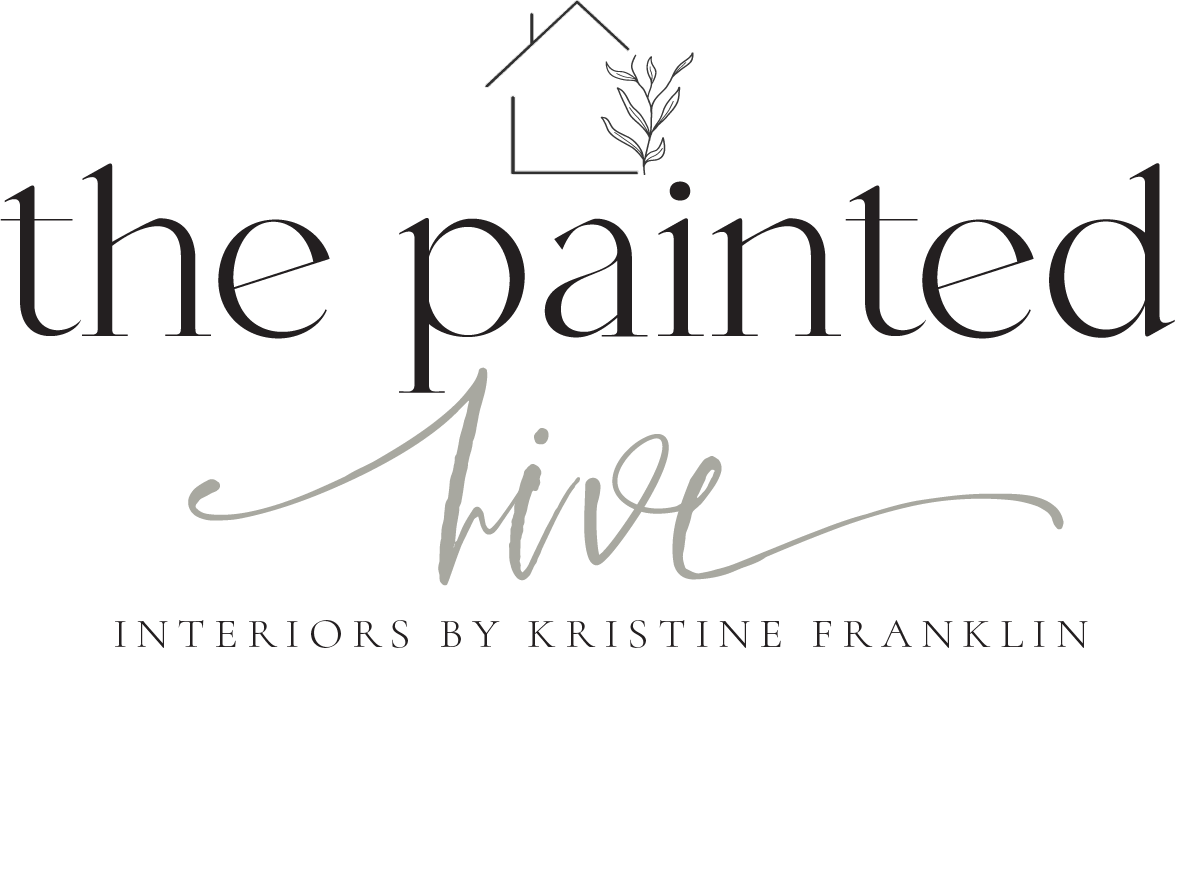
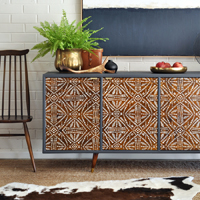
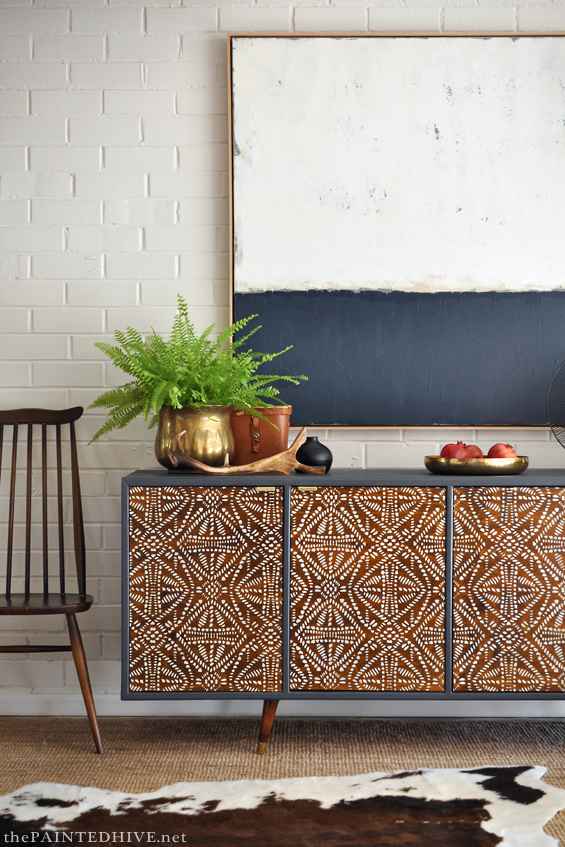
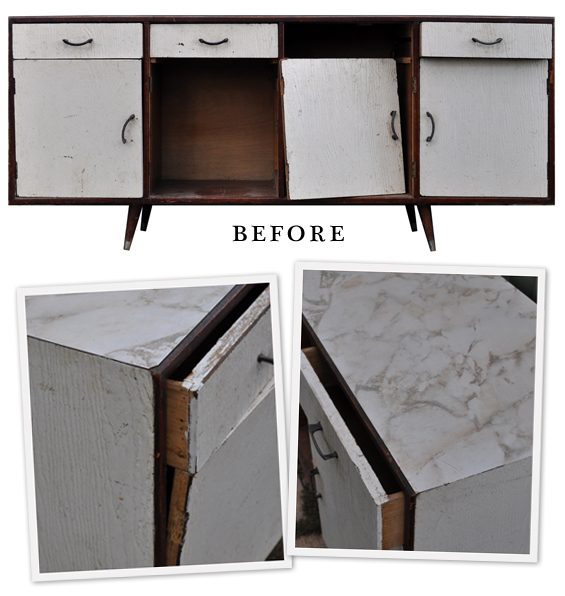
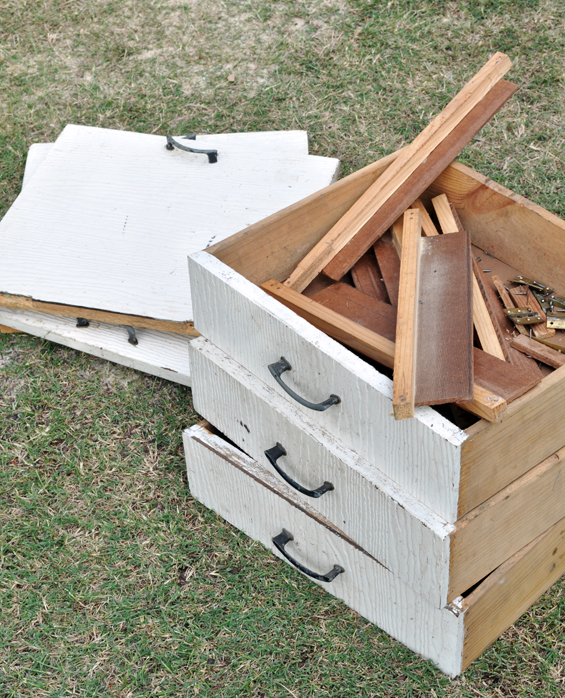
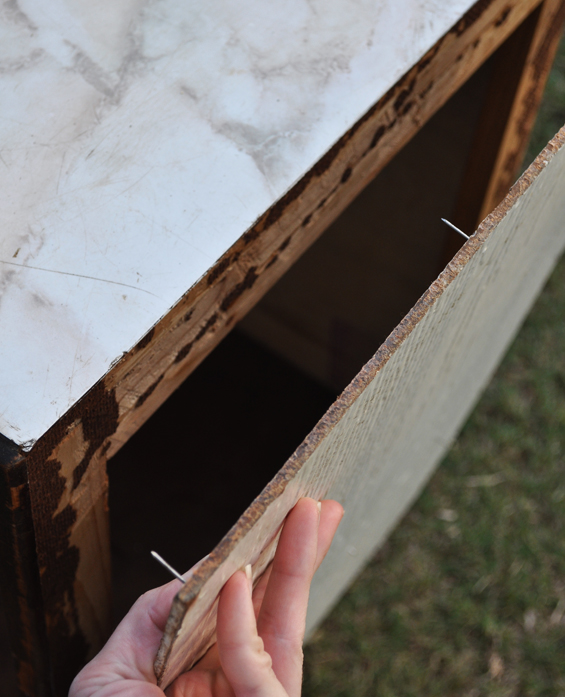
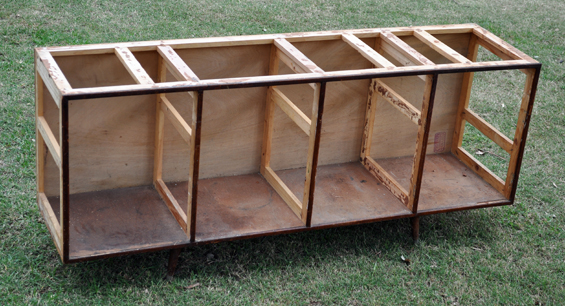
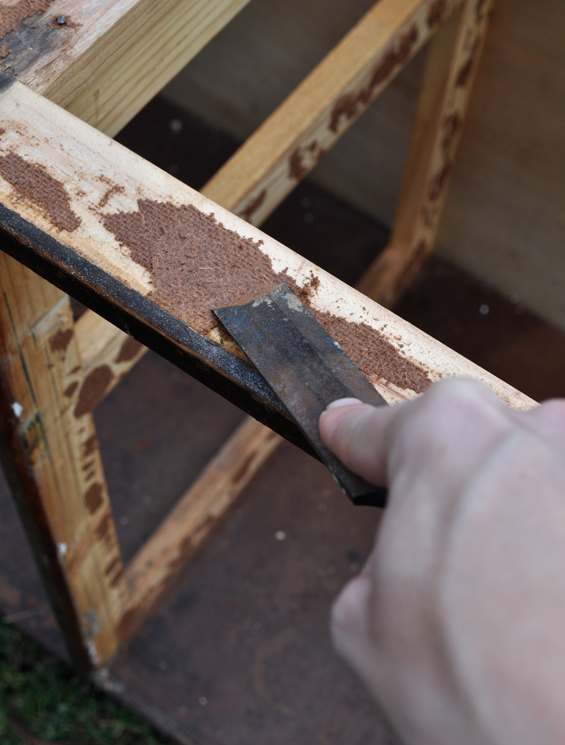

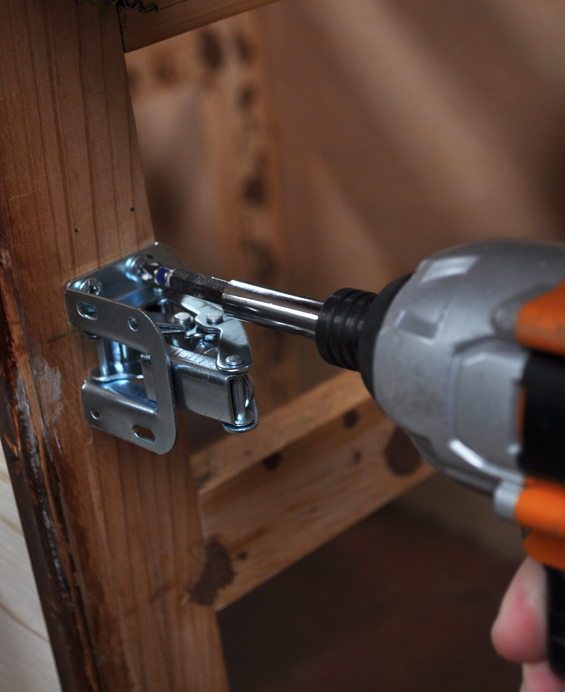
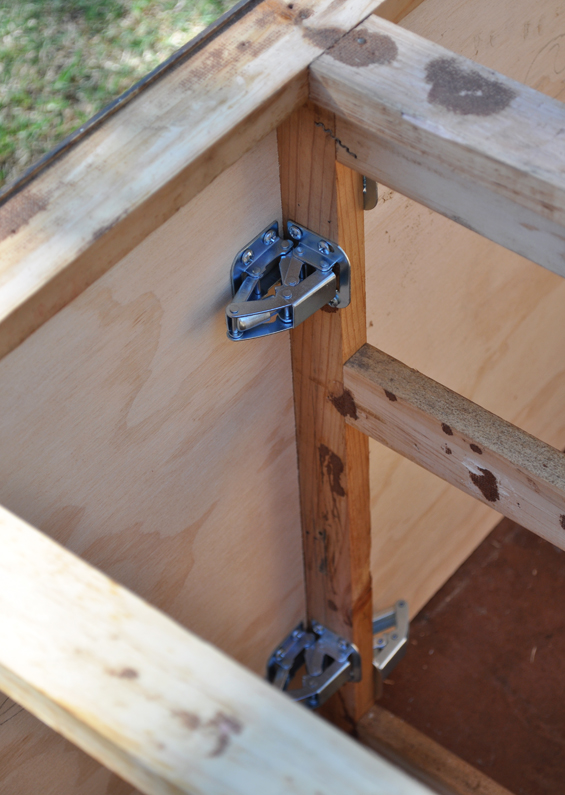
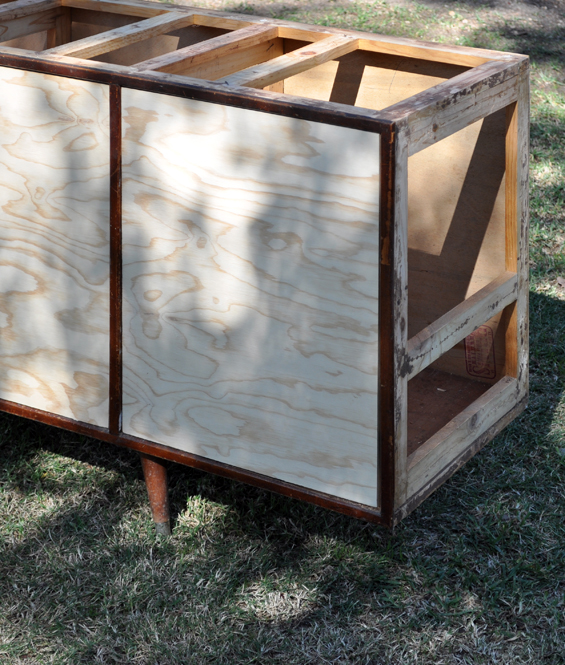

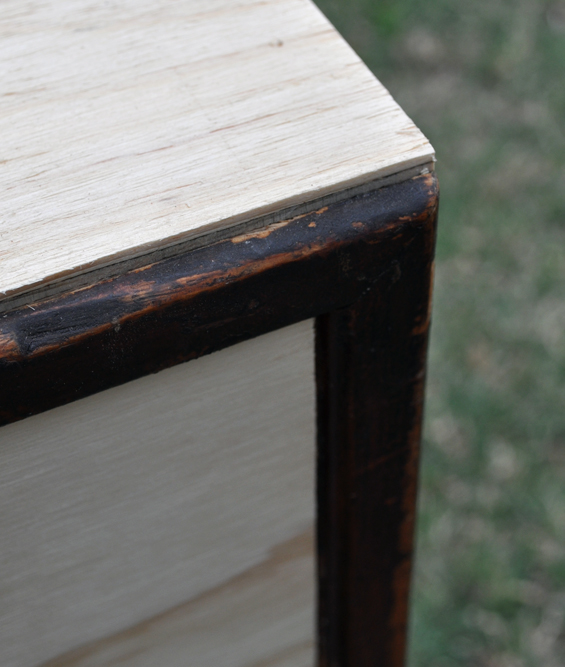
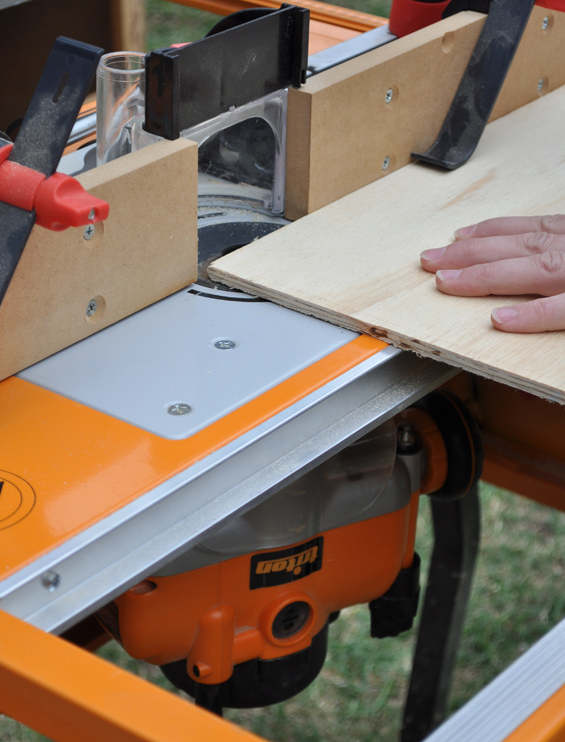
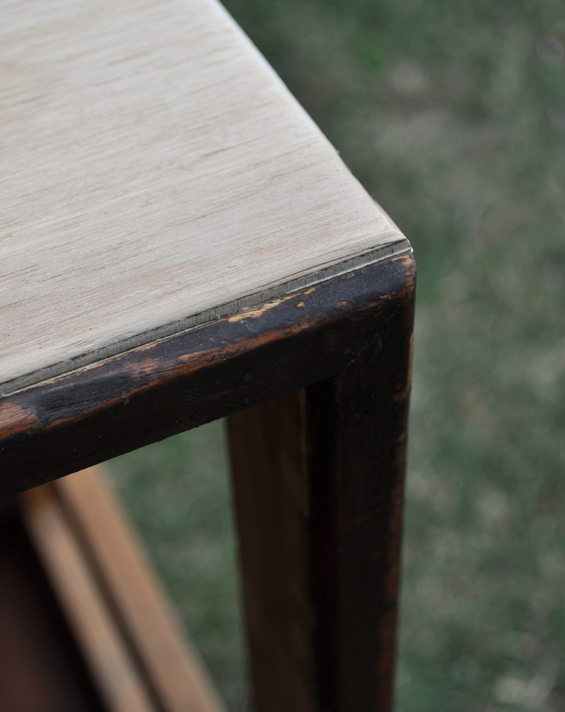
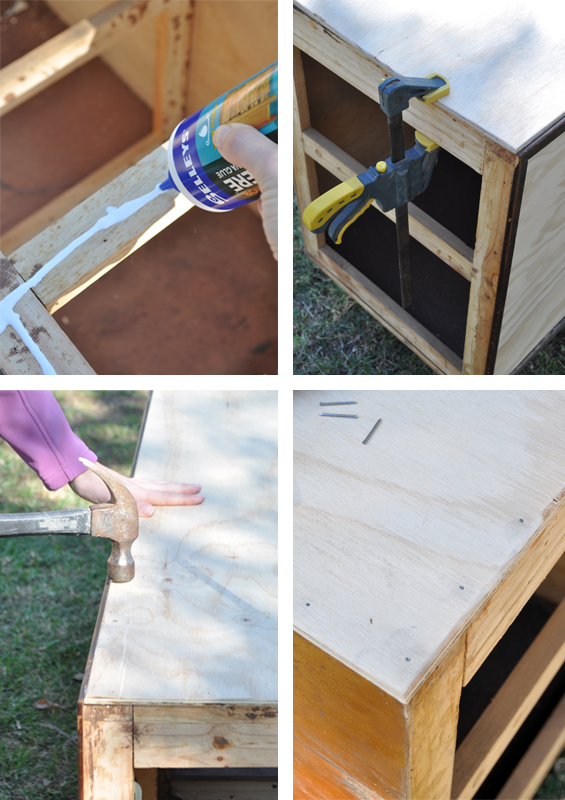
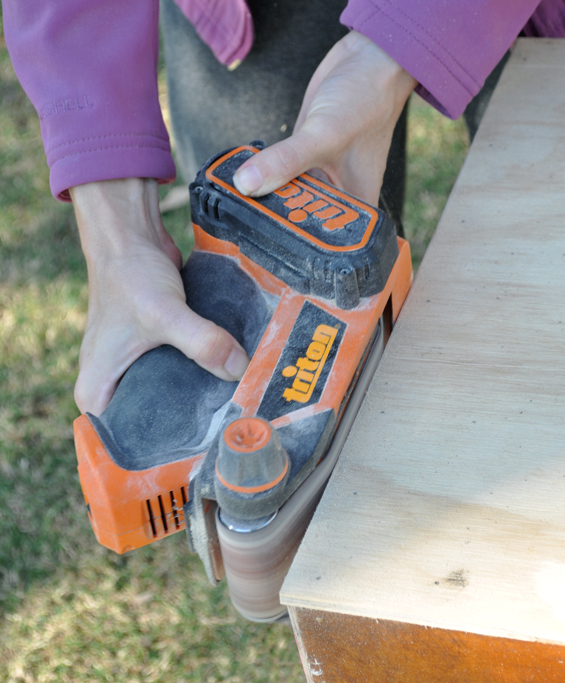
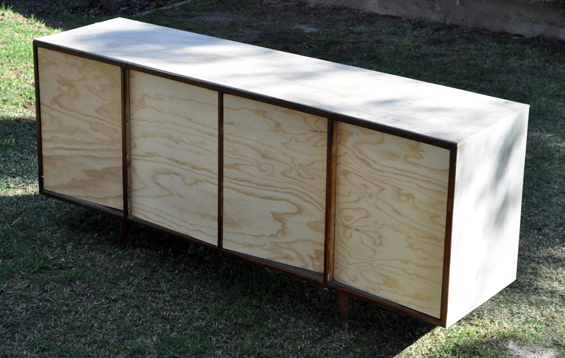
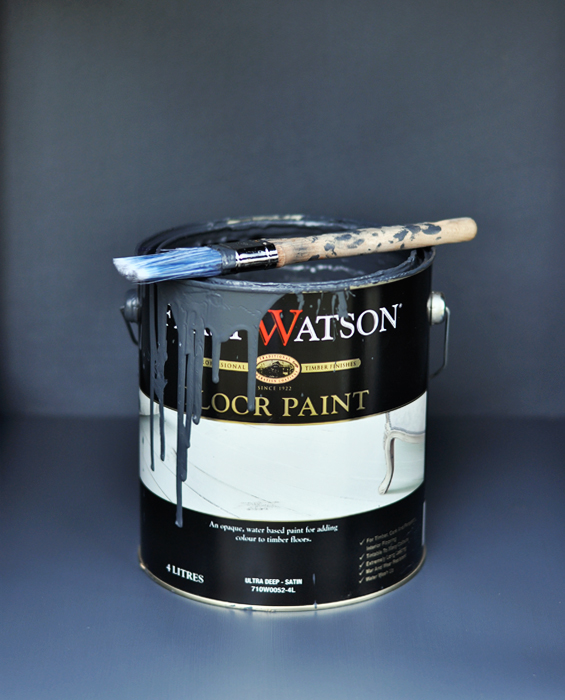
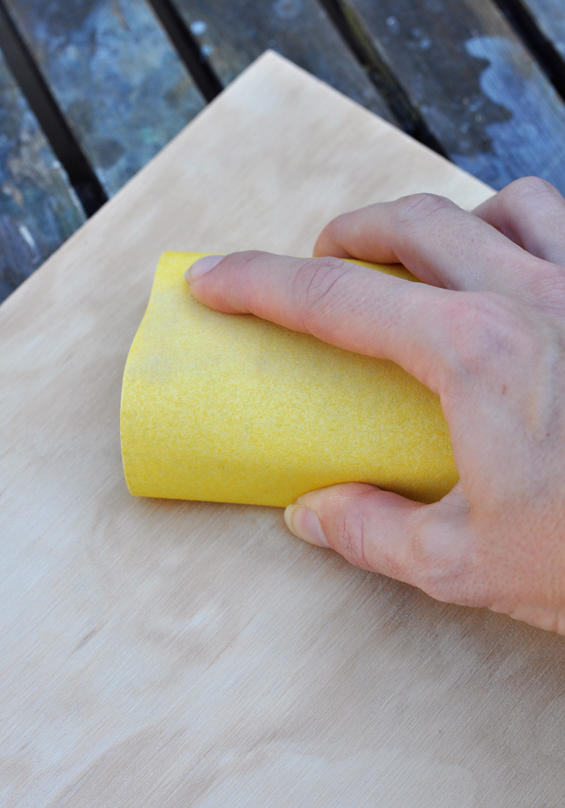
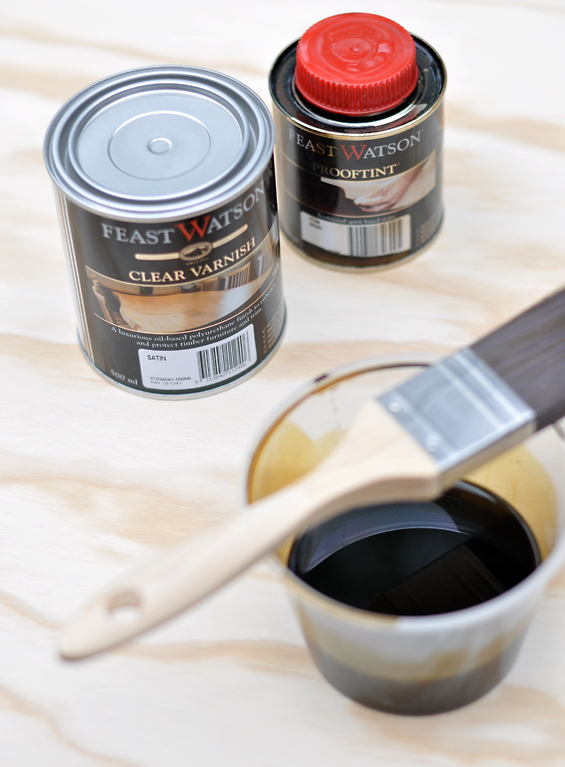
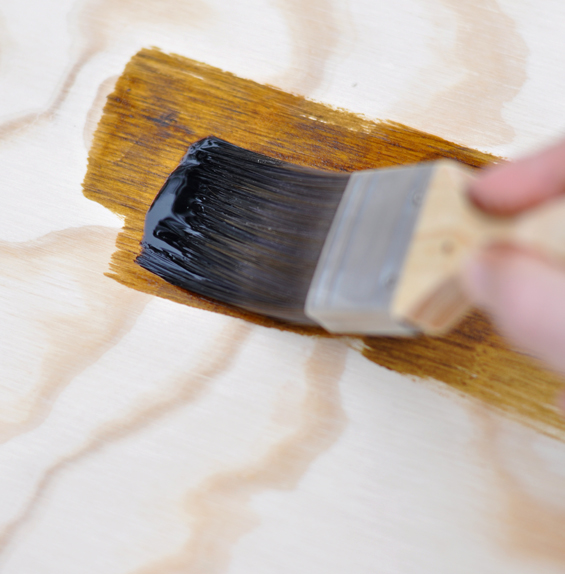
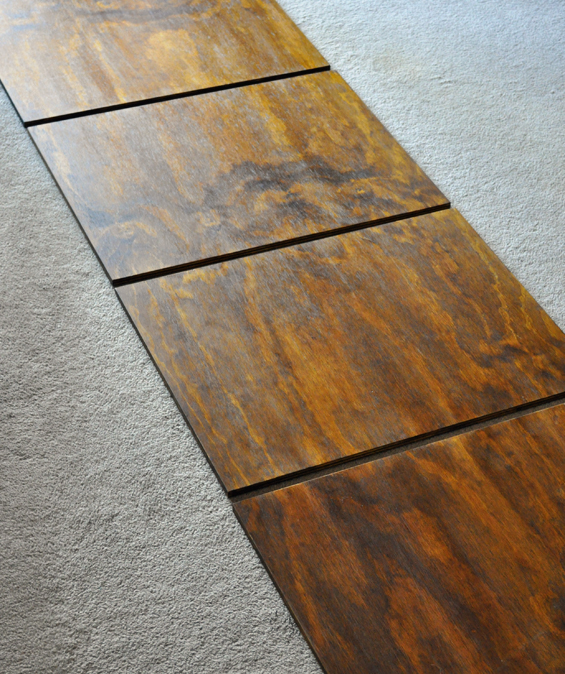
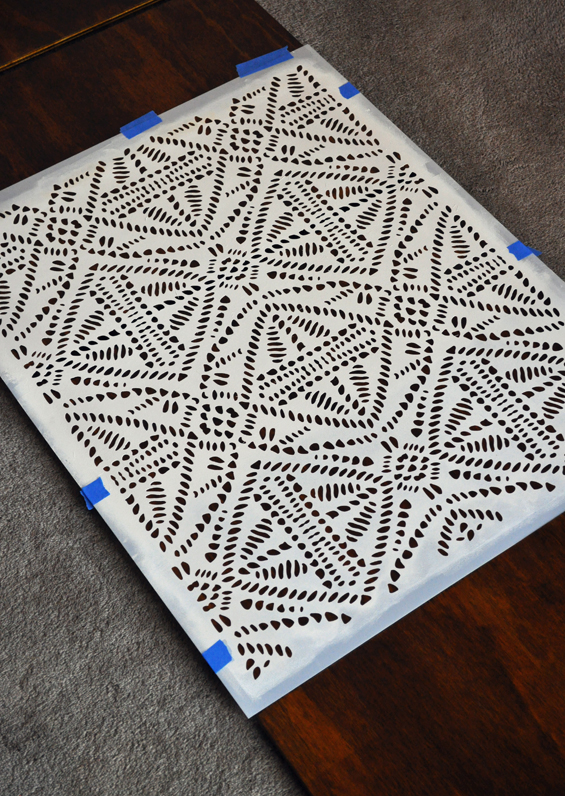
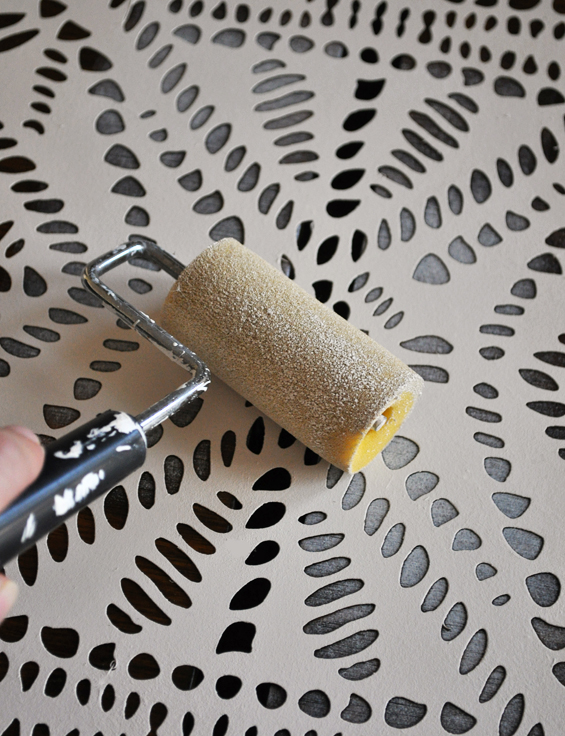
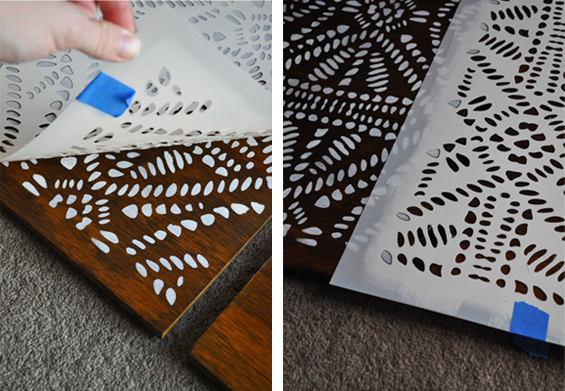
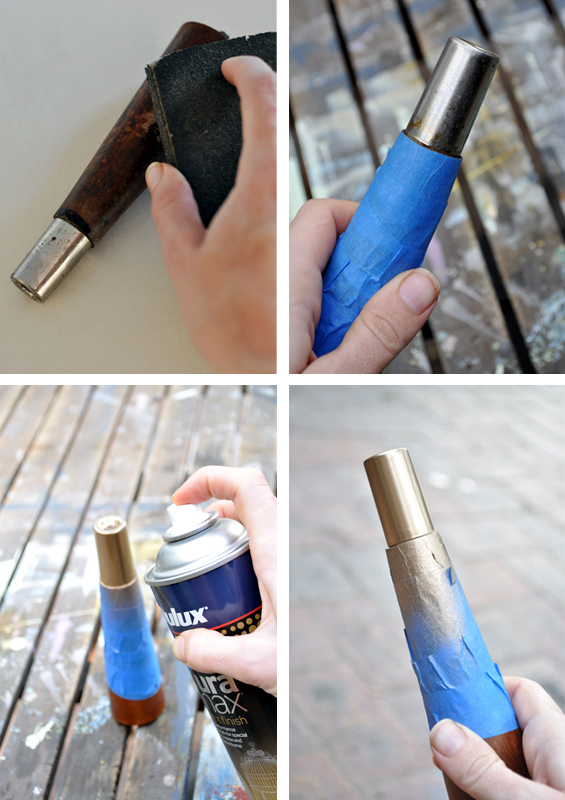
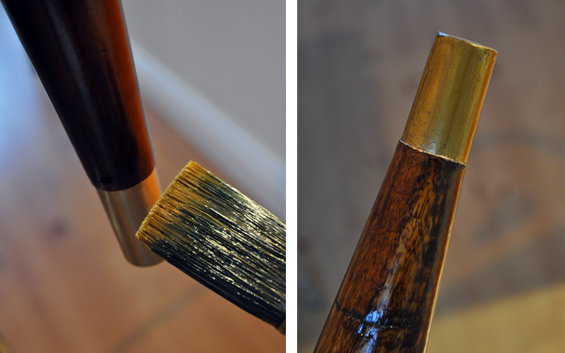
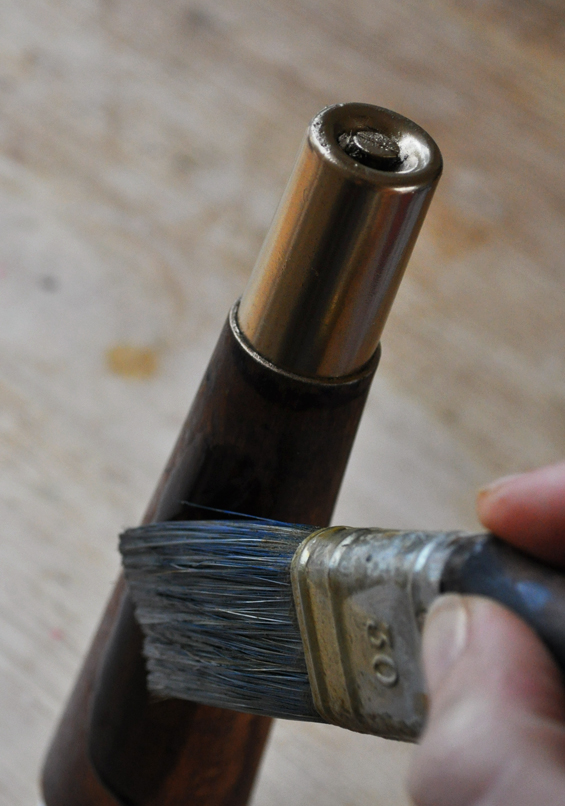
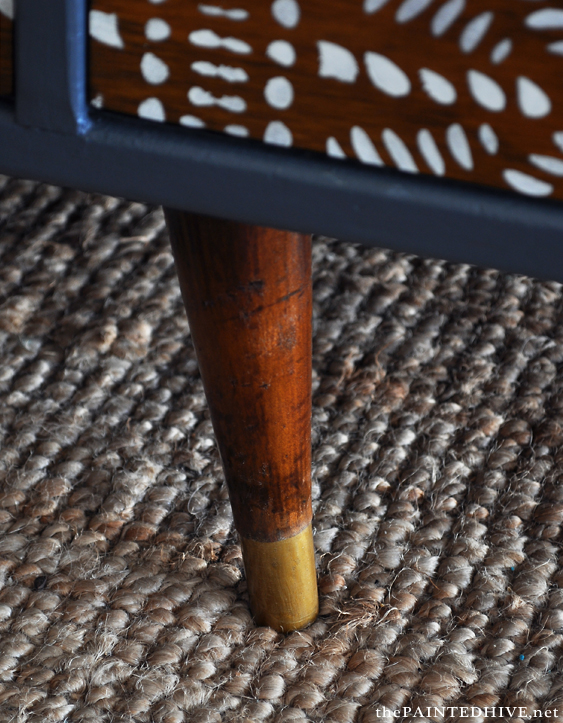
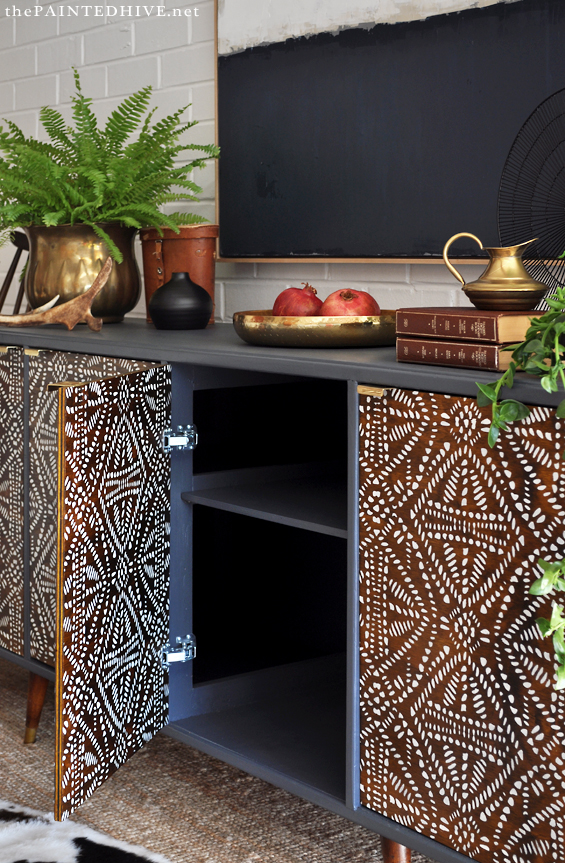
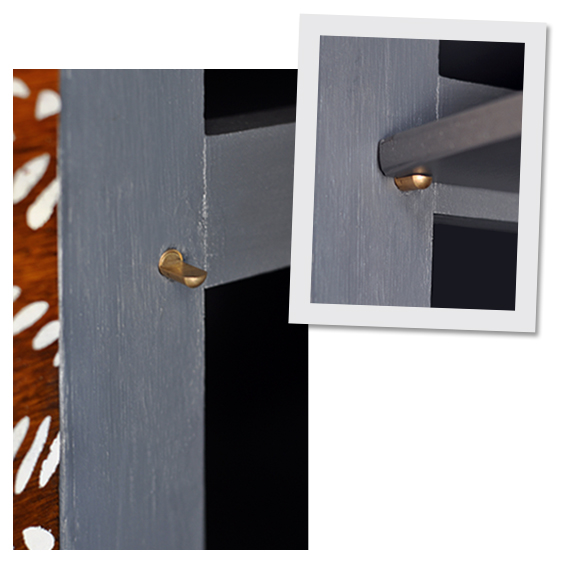
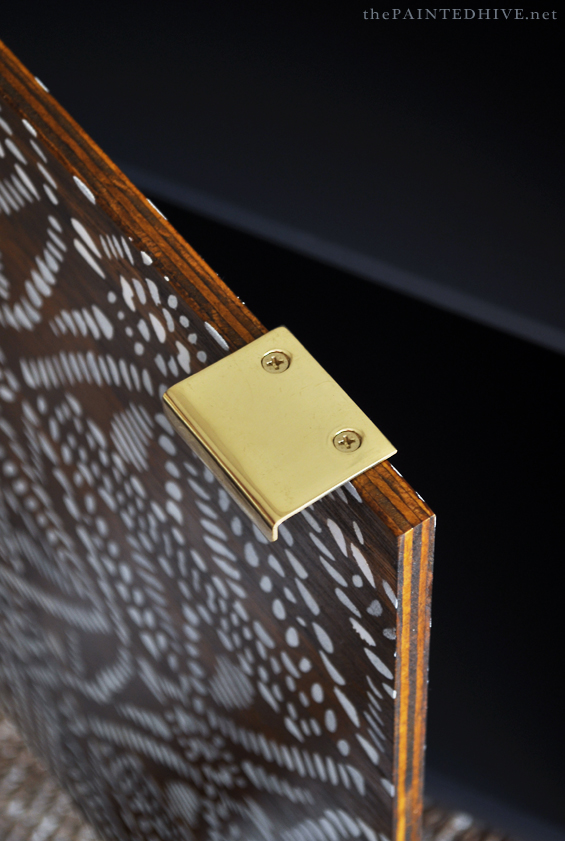
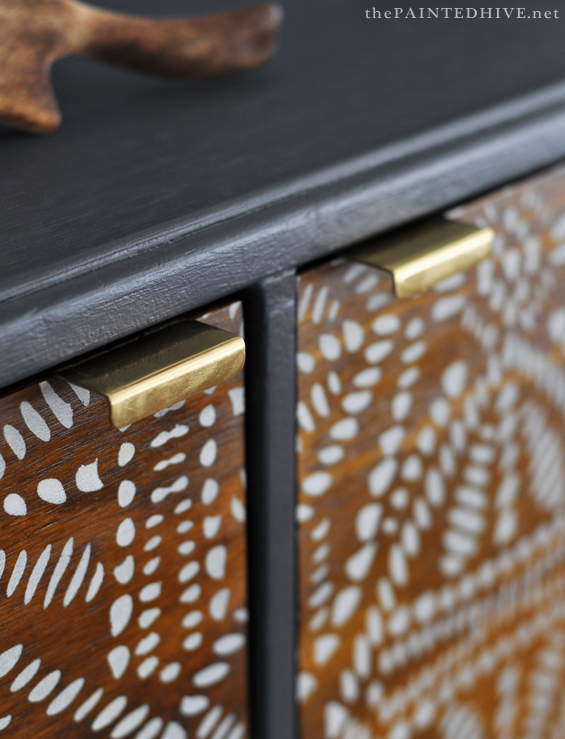
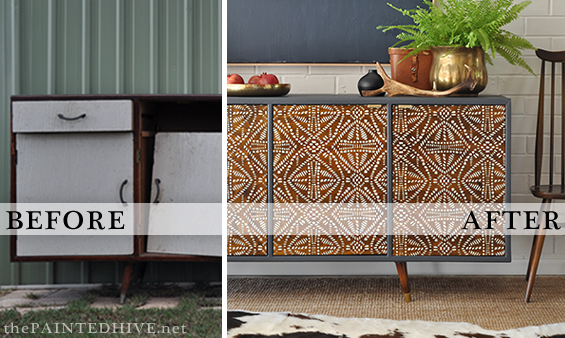
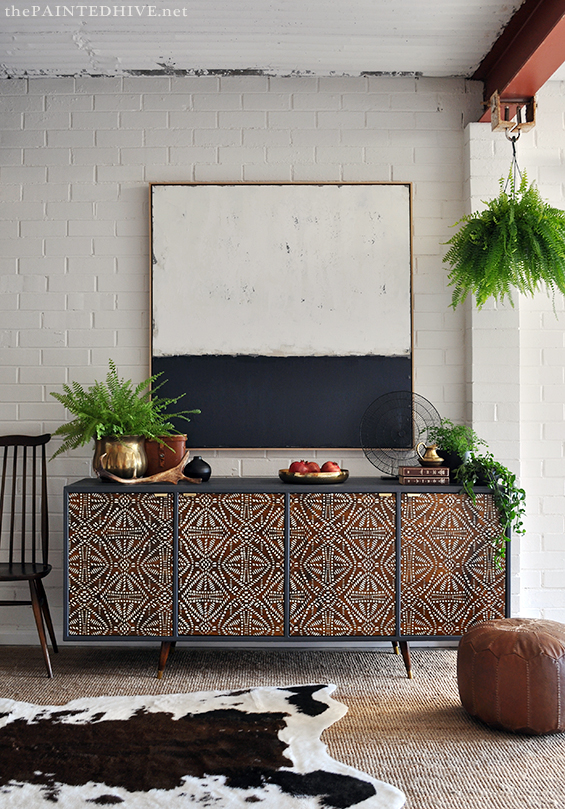

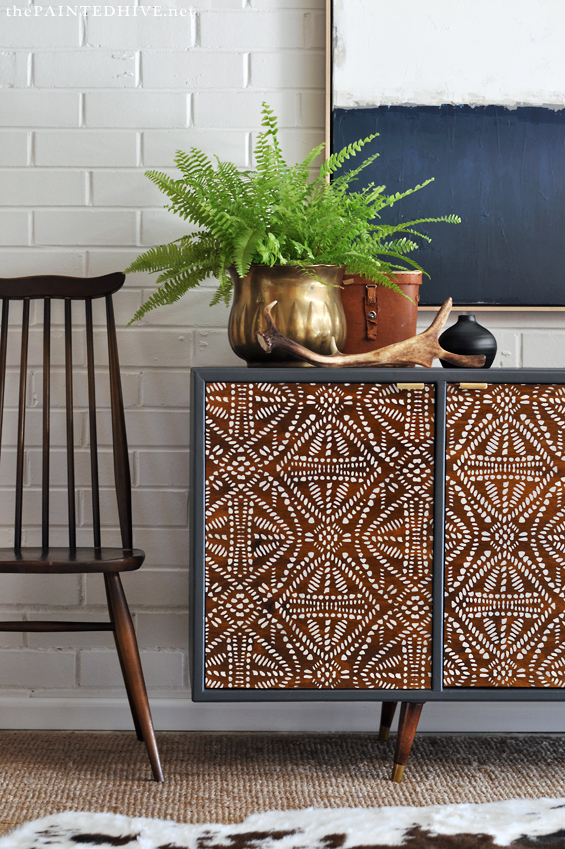
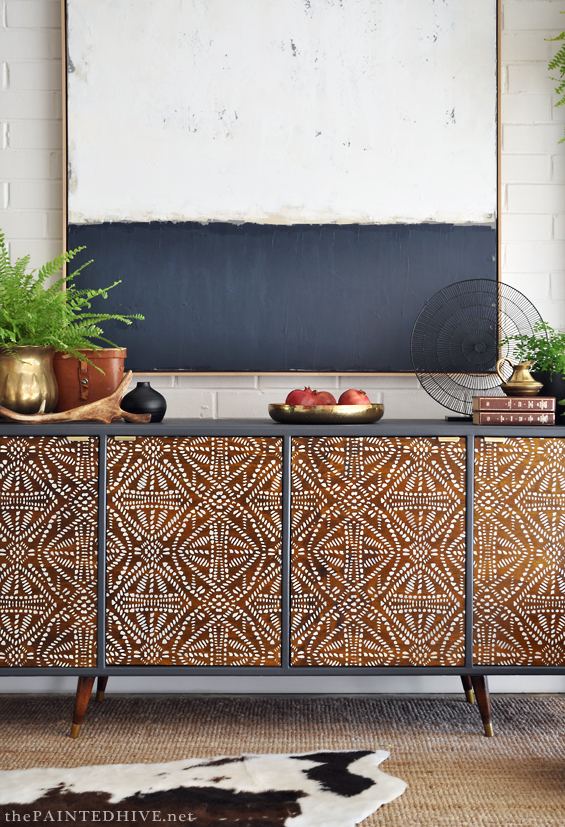
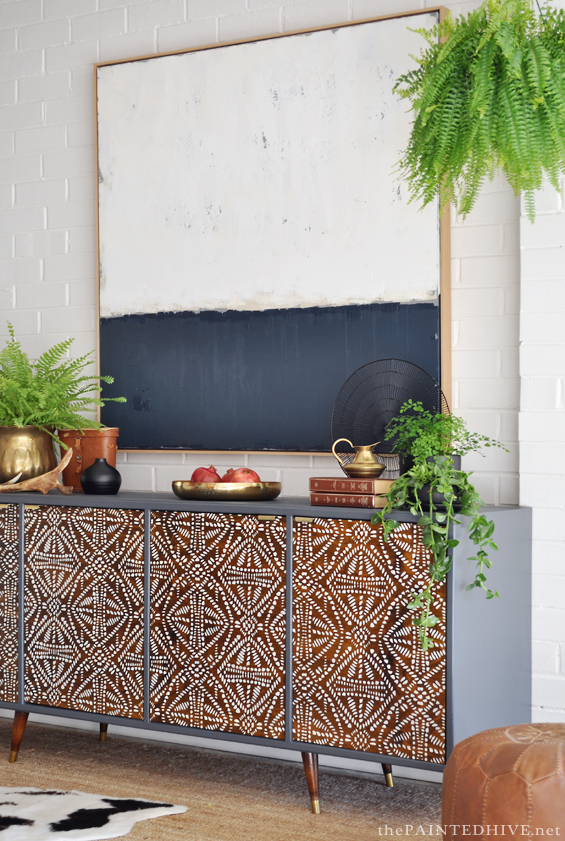
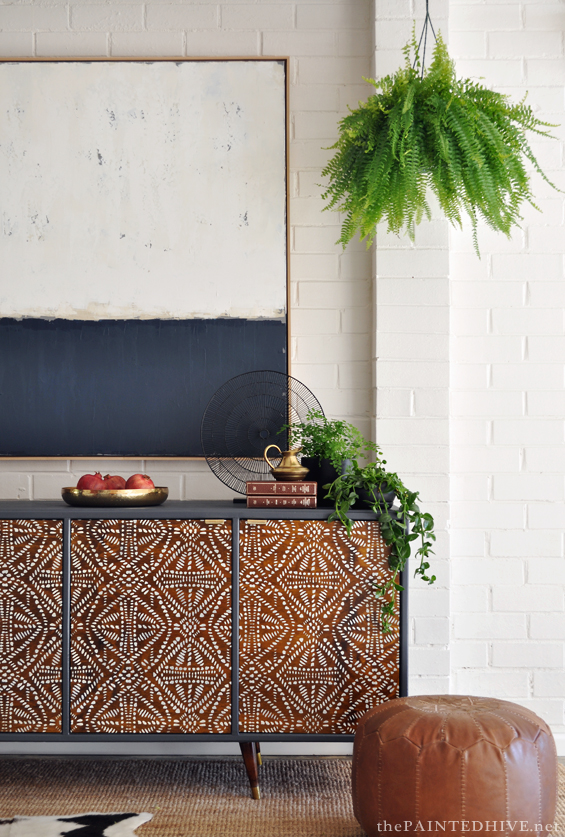
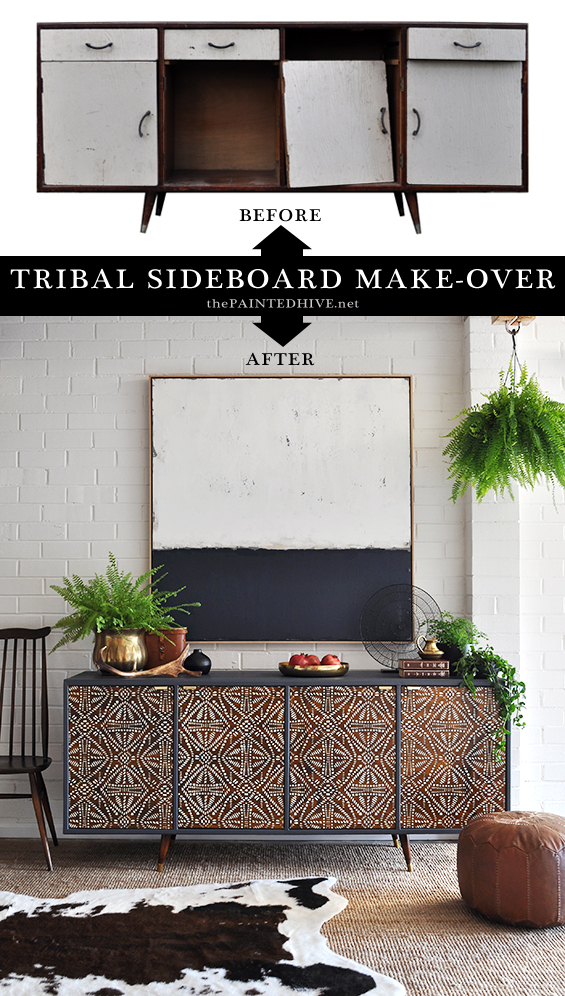
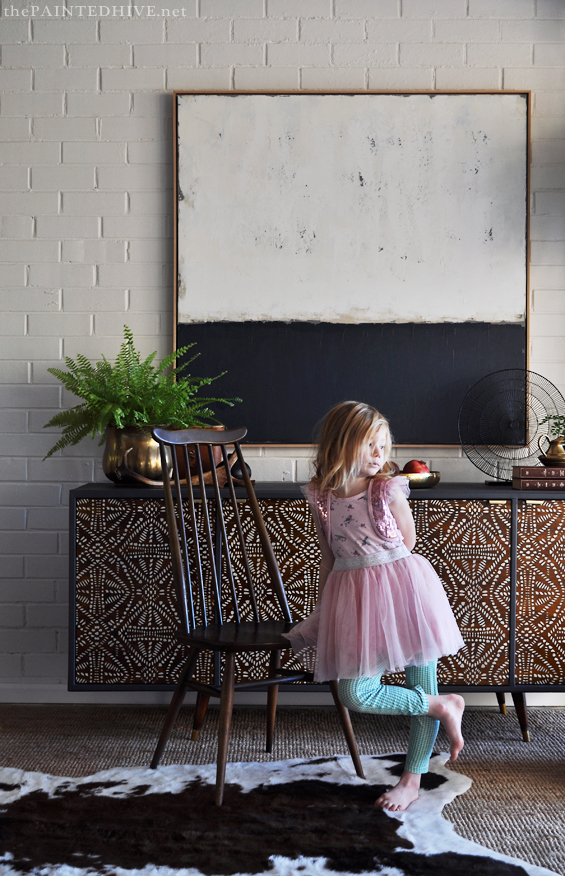
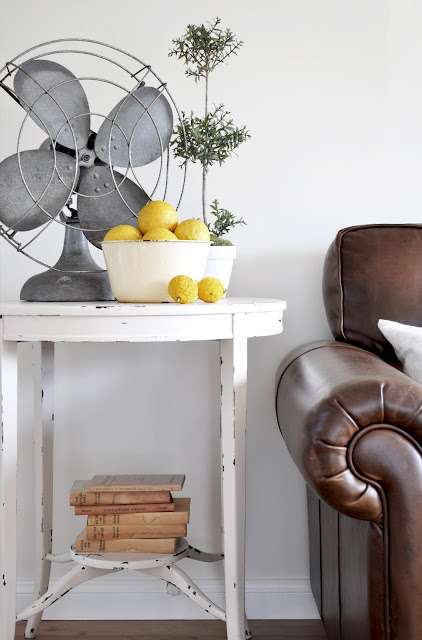
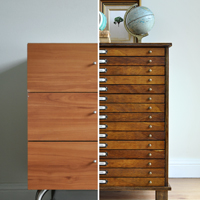
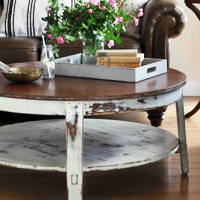
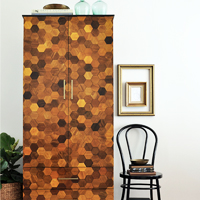
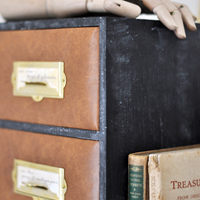


This is such an amazing makeover! Thanks for linking up to last week’s “Thrifty & Vintage Finds” link party on Dagmar’s Home!
I featured your post! http://www.dagmarbleasdale.com/2016/07/pinboard-redo/
Wowza! I can’t believe this transformation. Truly amazing! Thanks for the inspiration!
Thanks Erin :)
What a brilliant upcycle! I thought you had attempted aboriginal dot painting but then realised it’s a stencil, such a pretty pattern, it is really something special!
Thank you so much Michelle. I am kinda proud of it :)
Wow, Just WOW..
You did an amazing job. It is so beautiful! I really want one :) The stencil turned out great and the colors you choose are awesome. Nice job!
-Katie
button-jar.com/blog
YOU. ARE. AMAZING. Your skills, vision, patience, and altruism are astounding! You basically made a making a whole new item and you just killed it! I am very impressed!
Thank you so much. What a lovely comment :)
Wow, this is fantastic! Your blood, sweat and tears has paid off with this project and all for a truly amazing cause. Well done!
Hi Kristine,
I saw this when you first posted it, and thought it simply amazing! You have such a wonderful eye for design, and great ability to make that design happen. The choice of stain, stencil, paint colours, and the handles, too, are all simply perfect.
Today I received an email which tells me voting time is here for the projects, so i headed over there, wanting to vote for you. Sadly it looks like I had to be on instagram to vote, so i can’t do that. If there’s another way, please let me know. I also checked out the competition, and with due respect to all involved, and appreciation of their efforts for charity, they simply don’t have a chance. Yours is by far the best of the projects.
Well done on a fabulous job. All the very best for the auction.
Cheers, Liz (Wollongong)
Hi Elisabeth
Firstly, thank you so much for your lovely comment and support :)
Hmmm, who did you receive the email from? Feast Watson?
This campaign isn’t really a “competition”, however I believe Feast Watson is running a competition in conjunction with it where you can share your favourite Re-Love Project piece, on Instagram as you said, for a chance to win $2,000. If you don’t have an Instagram account, I don’t believe there is any other way to enter or support your preferred make-over.
Thank you again for your kind words :)
Kristine
x
Ha ha. Misunderstanding. I meant your competition, as in those whose furniture is also being auctioned. I realise it’s a charity fundraiser and not a competition per se, but it’d be lovely if your item generated most bids. I’m not sure who I received the email from, but it wasn’t Feast Watson. It was just something which came through my feed, I think.
Liz.
Thanks Liz. Given the caliber of some of the designers in this campaign, I think it’s highly unlikely a piece by little ol’ me will generate the most bids or the highest auction price :( That’s cool though. I mean, a bit disappointing though it’s just the way things role. I merely don’t have the same name or reach (and possibly even skill!) as some of them.
I really appreciate your support and kind words. Makes me smile :)
x
WOW!! You definitely have a great eye for design. Really cool and your daughter is adorable.
Ha, ha, thank you :)
Beautiful!! You are amazingly talented. Where is this stencil available?
Thanks Klara. There is a link in the post to the stencil. It’s from Royal Design Studio.
This piece is effin’ amazing! Great job! The stencil, subtle pull-tabs, and versatility of the piece are wonderful. You should be very proud of your hard work on this one!
Thanks so much Mara. It was a really rewarding project.
:)
What an impressive makeover! Looks like a lot of work but the end result is certainly worthy of the effort. I love the stain you used with overlaid stenciling. Thanks!
This is one of the most spectacular “After”s I’ve seen! All that pain-staking work certainly paid off. I hope you got (to donate) a bundle for it!
Thanks so much Nancy. The auction hasn’t taken place yet though I hope it does well for the charity.
Hi Kristine,
I was just browsing over at Royal Design Studios and there was an image of your buffet, advertising this stencil! Well done! You know you’ve done a great job when the company that made the stencil uses your item to show how good it can look. Happy days!
Cheers, Liz.
Double WOW on this one Kristine!
When I saw the first picture I was afraid to look further as I’m a lover of MCM and literally hurt when I see the usually beautiful wood, often walnut or teak, painted over. I braved it and scrolled down. The “before” made me very happy I did.
With your sharing of the bones of the structure, I know I can build this whole piece in our woodwork shop. Thank you for an awesome tutorial and great detail pictures.
~Becky <
Thanks Becky. Wow, you’re considering building something similar from scratch? I totally take my hat off to you then as construction is NOT my strong suit. If you do make a sideboard, I’d love to see it. Feel free to email me the pics :)
One of my favorite repurposed/reloved ideas EVER! What an incredible artist with such a unique vision for something most of us would stay clear of! Another fabulous creation. Thank you for sharing!
Thank you so much :)
Beautiful sideboard!!!! Can you get the artwork in the USA. The website says you need a valid Australian website?
Sorry Jan. I don’t think Freedom deliver to the USA. I actually believe that artwork has now been discontinued anyway.
You did an amazing job and put in a lot of work! The finished product is gorgeous. Well done and beautiful — you can’t ask for more. I saw your link at To Grandma’s House We Go party.
Just a stunning transformation thanks so much for linking up with us at the to Grandma’s House we go link party! Pinned!
It’s lovely. I’d be proud to own a piece as nice as this.
Thanks so much Cindy :)
Found you via Apartment Therapy and have to say, this is INCREDIBLE. I’m absolutely floored what you created here. Beautiful job, I’d be proud to have that in my home! Stunning job!! xx
Thanks so much Kimberly :)
Thanks so much for sharing your process! very thoughtful reno and it looks immaculate and truly one-of-a-kind.
(The black and white painting above it is delicious! Yours..?)
Thanks Cate. I was going to DIY an abstract painting for the shoot though I ran out of time. This one is borrowed from a furniture store.
x
Wow what an amazing makeover on the sideboard. Seriously Gorgeous.
Do you mind if I ask, where did you find that painting in the photo? Love your site.
Thanks Angela. I borrowed the artwork for the shoot from Freedom Furniture. I think it’s discontinued now :(
Not a difficult DIY to try!
Wow! Now that’s a makeover! Love it, and will be featuring it on The Creative Circle Link Party. Thanks for sharing!
Thanks so, so much Iris :)
YOU. ARE. A. BEAST!!! LOVE IT. GREAT JOB
LOL, thanks heaps.
Hello, I would like to know if that picture frame is for sell.
Hi. Sorry, I borrowed it for this shoot though it’s now discontinued.
Wow. One of the pictures from this appeared in a Pinterest email today. Loved the pic, but when I clicked through I just had to read the whole thing. You did such an incredible job. I’m so blow away by your amazing taste too – off all the places you could’ve gone with this piece, your choice of a stencil in that restrained pattern, the choice of handles…so different from anything else I’ve seen but so perfect. I’d love to know what happened in the auction. I hope your piece was one of the most hotly bid on!
Thanks Abbi. The auction was quite tame though it did well enough in the end. From memory I think it sold for around $600.
Visiting you via Apartment Therapy. I am a DIY’er and this literally made my jaw drop. Wow, wow, wow! It reminded me of a similar piece I worked on years ago but not nearly as bad as what you started with. Thank you for sharing both the good and the bad scenarios of this makeover. It is beautiful!
Absolutely amazing! One of the best makeovers I ever saw, if not THE best ever!
Too beautiful for me to find words for. (And the sideboard reno is pretty okay too.) Hehe. I’m talking about Charlotte =)
And did you design the bold and simply stunning print above the sideboard? Who’d have thought that something so simple could be such an eye-catcher. Love it.
Hi Geri. I thought about painting an artwork however I ran out of time. This one was borrowed from a furniture store though it would be an easy DIY.
Wow..I’m speechless..absolutely stunning..
Thank you :)
That came out beautiful. Love the detail you gave it. You should be proud of that one.💕
Thanks Lynn :)
Where can i get that artwork? I’m in love with it.
So sorry, this project is from a few years back and that artwork is now discontinued. Wouldn’t be too hard to DIY :)
I love this, i am totally into the NorthAmerican Indian, (I’m part Indian so iit’s appropriate to collect Indian artifacts (the ones I can afford, anyways ) and it reminds me of something they would make. So I have to try it, i was thinking of redoing my Motherinlaws record and radio cabinet from the 60’s I believe but it’s seen it’s fair share of dings and bangs and coffee rings and all not in a good shabby chic way either ! I love the way you write, great sense of humor and you are very talented so I am subscribing and love to follow along to see what else you come up with ! Thanks for inspiring me, now I just need the motivation to go with it, lol.
I bookmarked this post almost 2 years ago and just found a $40 mid century modern dresser on Craig’s List that I will treat in a similar manner. I love love love this project and have dreamed of doing something like this! Thank you so much for the inspiration!
Oh yay! I’d love to see a pic once you’re finished. Feel free to email me: thepaintedhive@gmail.com.
Kristine
Lovely beautiful, thanks for sharing a very nice blog post amazing.
This is awesome! What color is the white you used?
Just bright white (untinted) straight from the tin :)
Another one from Trash to Treasure. Your foresight is amazing! You hit all the right details; from the gray against beautiful wood, to the very cool tribal stencil, and the very unique door pulls that don’t distract from the pattern!
I have just now followed you and am wasting my day in front of the computer reading all your old posts! I am rationalizing my jammies and coffee cup with the idea that some idea of yours will propel me outta this chair ;)
Ha, ha. Thanks :)
Absolutely fantastic makeover! And the placement and decor around it and on it – PERFECT!
Just seeing this…many years later. Holy smokes, I am inspired, thanks for sharing!
Thanks so much :)
Unreal. You are incredibly talented.
Wow wow wow, this is awesome ! You got me so inspired !
SO much that I am checking out the stencils haha : did you actually use the wall or the furniture one ? On the picture it seems to me as your pattern is bigger than the furniture one.
Best regards,
Luleta
Thanks so much.
This is the wall one. I wanted the pattern to be larger in scale than the furniture size :)
Wow, such vision! Simply beautiful!
Thank you :)
This is beautiful! I LOVE the stenciling. I actually just did a similar makeover with a decrepit microwave cabinet. We turned in into a coffee bar! Definitely some tough parts like you (the doors) but it ended up amazing! Thanks for the inspiration to not pass by the crappy furniture and its potential! :)
You had my interest, immediately!! Your detailed description nailed it!!
I’m going to give it a try!!
Loved your vision approach and tenacity!!!
Beautiful piece!! Quick question: did you use the furniture stencil version, or the all-over wall sized stencil for this piece? I’m considering getting the wall sized so I can easily do some larger projects, but I am afraid it might be too large for furniture. If you could give me any hints on what you used or your opinion of which would be best, I would sincerely appreciate it!
Hi Amanda. I used the wall stencil. Wasn’t overly large and worked well for the size of my doors. I think it might be tricky to use on drawers as there would be quite a bit of overhang.